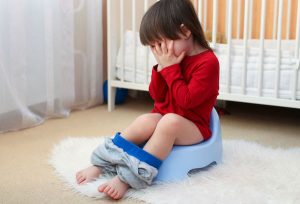 It’s always a good idea to check in with your child’s pediatrician if you’re having a hard time potty training, but these are some of the most common issues that pop up, along with expert advice for overcoming them:
It’s always a good idea to check in with your child’s pediatrician if you’re having a hard time potty training, but these are some of the most common issues that pop up, along with expert advice for overcoming them:
Highlights:
|
Resists Starting
If you try to introduce potty training and your child resists, make sure they’re ready. This list of readiness factors is a great guide. If they’re missing many items on the list, you may want to wait. If readiness isn’t the issue, they may be intimidated by the idea of peeing and pooping in a potty, which is normal. Try using some of these tips to help them feel comfortable with the idea.
Constant Power Struggles
If you’ve ruled out readiness and intimidation and your little one fights you simply because, well, they’re a toddler, stay calm. Experts warn that negative reactions like punishment and coercion around potty training can lead to constipation, urinary tract disorders and even phobias. If using the potty has turned into an all-out battle, consider a slow and steady, child-oriented approach. It may take a little longer, but it’s a good way to keep the process positive.
A Bump in Accidents
Sometimes after a long stretch of successful potty use, children suddenly start having accidents. Again, it’s important to stay supportive even though this can feel frustrating. Sometimes life stressors like starting school, a parent starting a new job, a new sibling, or any other change in routine can bring on a phase of potty accidents. Gently reintroduce potty-training activities until they get back on track.
Refuses to Use a Regular Toilet
It may seem easier to start out with a potty seat that fits on top of a regular toilet seat. Some children are okay with this, but for many it’s too scary. They’re used to the feeling of pee and poop being close to their bodies. Letting it go into a big toilet and watching it flush away can be frightening. Try starting with a potty that sits on the floor, then transition to the toilet seat after your child is comfortable using the floor potty.
If they’re already using a floor potty successfully and they still push back on using the toilet, you may need to bump up the encouragement, praise and/or rewards. Putting a step stool in front of the toilet that they can put their feet on can also help them feel more comfortable and secure.
Refuses to Poop in the Potty
This is one of the most common potty training roadblocks. Don’t tell them to push or strain. This can cause fissures (tiny tears) or hemorrhoids on the anus, which can lead to holding poop, which can lead to constipation, which can lead to more hemorrhoids. Instead, several things may help here:
- Offer extra encouragement, praise and/or rewards.
- Use distractions that keep them on the potty and relaxed until the poop falls out. This could be special books or toys that only come out for potty time, or even just you crouching next to them and talking, singing, or telling a story.
- Allow them to poop in a diaper if that’s the only way they’ll do it. Let them know they can use a diaper but only in the bathroom. Next, they can use a diaper, but only while sitting on the toilet. Then, they can use a diaper while sitting on the toilet but only after you cut a large hole in it so the poop falls into the water. Phew, that’s a lot of work. But it’s very important that they poop regularly or else they may get constipated.
They Get Constipated
If they do get constipated, mention it to their pediatrician. Chronic constipation can lead to serious health issues, so it’s important to get your tot pooping again as soon as possible. Oftentimes upping their fluid intake and adding high-fiber foods to their plate does the trick. Exercise can help keep bowels regular, so be sure they’re getting enough time to move their body. If these don’t do the trick, your pediatrician may prescribe medication.
Above all, try not to get discouraged. Potty training can be tricky, but these tips (and a lot of patience) can help you get to the other, diaper-free side.










